Buongiorno! Good morning! Or just plain howdy, as we say in Kansas. (Well, some of us do…)
While getting back into the Studio Routine last week after a short break, I revisited my impromptu reticello sampler and discovered that it doesn’t take long to forget certain important steps. It’s weird how a week away from routine can be so disorienting!
Today, I’ll show you some slight progress on my sampler, I’ll share a tip and a tool with you, and then I’ll share some news about some fabulous books that I’ve brought in for you!
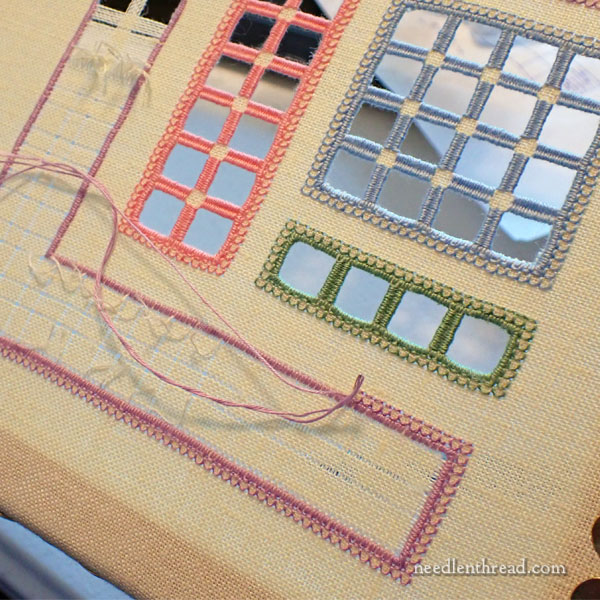
Since we last visited this sampler, the only new element on my reticello sampler is this window – in purple – that takes a corner. This was a little more complicated than the regular square windows, requiring calculations and marking in multiple places with pins.
I decided to start with the satin stitch border, rather than beginning by withdrawing border threads and then satin stitching. I’ve experimented back and forth with each approach: withdrawing a border thread all around the area you plan to open up and then satin stitching the border; or satin stitching the border and then withdrawing the inside border thread right next to the satin stitch.
Typical of most needlework techniques, there’s no Only One Way to Do It. It really depends on the stitcher’s preference. I don’t see a structural reason why it should be done one way or the other. I prefer satin stitching the border first, before removing any threads.
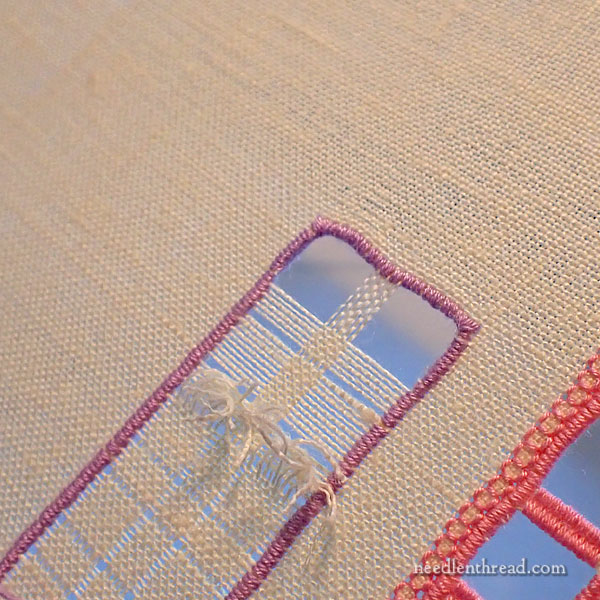
One structural point that I think is important, though, is that the border – satin stitch and four-sided stitch outline – should all be worked before withdrawing the main threads to form the foundation bars!
I completely forgot to work the four-sided stitch outside the satin stitch, and while it isn’t absolutely necessary (and it could actually be a different stitch rather than four-sided stitch), this extra stitching beyond the satin stitch outline helps add some structural support to the fabric. The extra structural support comes in handy when removing threads.
You can see in the photo above that the satin-stitched-only border of the cutwork area looks a bit wobbly!
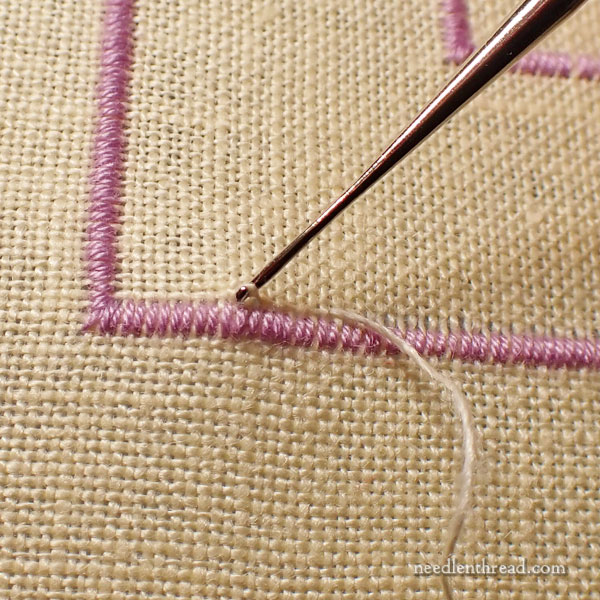
When you’re withdrawing threads for this type of work, a hook – a tiny crochet hook or something similar – is a Very Handy Tool!
I’ve used tiny crochet hooks in my embroidery life for a long, long time. They can get you out of a real jam for pulling through threads that too short, for repair work, and for all kinds of situations where you need to grab a thread and get it through some space, and your fingers or tweezers or a straight needle won’t quite do the trick.
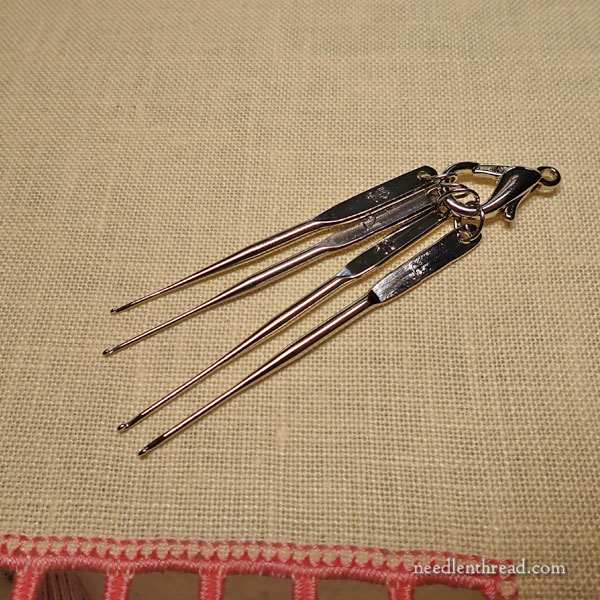
I like this set of four tiny crochet hook ends – they’re truncated crochet hooks without the longer handles. The set includes sizes 10, 11, 12, and 15. The 15 is ideal for withdrawing threads on higher count linen.
But you can also use any tiny steel crochet hook. A 0.5mm hook works great!
Books Coming In!
I will very shortly be adding a selection of Giuliana Buonpadre’s reticello and related needlework books to my shop.
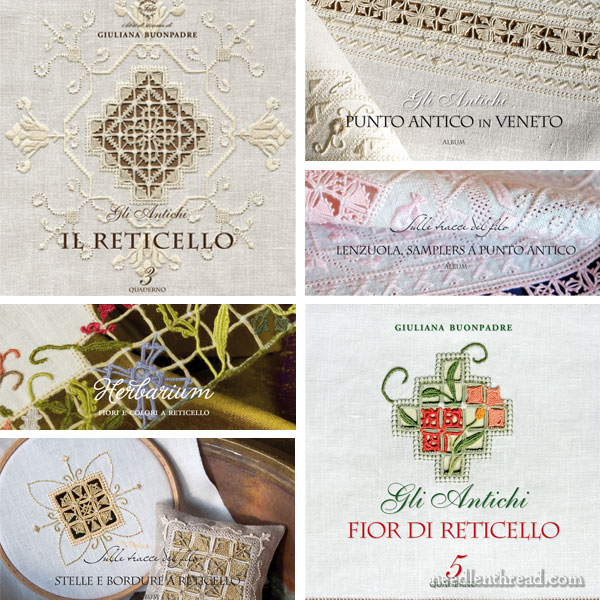
Giuliana (who sadly passed away with leukemia, may she rest in peace) was an expert and true artist in needlework. Her gorgeous traditional and contemporary reticello work is well-known to needleworkers world-wide. I will be carrying seven of her books on reticello (including her book on hardanger), and if there is interest, I’ll bring in her other three remaining books as well.
The books are published with instructions in Italian, French, and English, and loaded with instructional diagrams.
I’ll show them to you up close when I launch them, which should be by this Friday. So, if you’re keen on needle lace, on reticello, whitework, modern drawn thread and needle lace, enticing ways to add color and free form elements to reticello and hardanger, and just really beautiful needlework, keep an eye out!
If you have stitching friends who love needle lace and find hardanger and want to let them know that I’ll have these books available, please feel free to share the information!
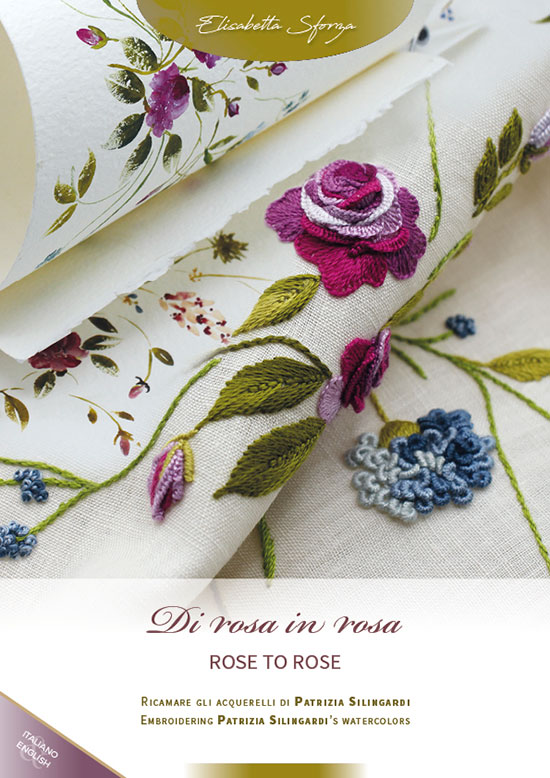
Also, a heads up! Elisabetta Sforza’s gorgeous new book Rose to Rose will be arriving shortly, too, along with a re-stock of her other books. I’ll review Rose to Rose in depth soon for you.
At this time, I’m not taking a waiting list on these books. Once I’ve processed the books, I’ll add them to the website and I’ll let you know through the blog here when they’re ready.
One of my goals for the website is to curate what I consider really beautiful and instructional needlework books that can’t be had through the normal online book outlets. I’m so happy to be adding all of the above to the collection!
I’ll keep you posted on the books and on the reticello sampler. I can’t wait to start dabbling with needle lace in those colorful windows!
Happy Monday!







I’m so glad you mention those tiny crochet hooks. I use size 11 and 12 all the time for weaving in short cross stitch thread tails. I have half a dozen so I can keep one in each of my project bags. I will show my husband yours with the holes in the handles and ask if he can duplicate them with a vise and drill. Best tool ever!
I love Reticello! Thank you for your posts and photos. Bit where, oh where can I get the crochet hook ends please??
I found them at Handy Hands:
https://hhtatting.com/product/mini-hook-set/
Hope that helps!
I have quite a few of Giuliana Buonpadre’s books and they are wonderful! Beautiful illustrations and excellent instructions.
I’m so very excited by the new books you’ve got coming in on reticello/a – can’t wait!!
Any suggestions on where I can find the set of shortened needles/hooks? I do use a long fine hook, but I like the set.
Thanks!
Laura
I found them at Handy Hands:
https://hhtatting.com/product/mini-hook-set/
Hope that helps!
I’ve been using a Hemline Snag repair tool (device with a tiny latchhook) to nab loose threads. It works very well.
I have several of Guiliana’s books and they’re excellent! I look forward to reading your thoughts on the ones I’ve not yet acquired as well as Elizabetta’s new book. I loved her ‘In a Wheatfield’ and these roses look equally delightful.
Cara Mary, sono felice che arrivi anche il libro di Elisabetta Sforza, che deve essere magnifico.
Ho visto che hai parlato dell’Arazzo di Bayeux: io e Giuliana lo abbiamo visto nel suo museo, costruito apposta a Bayeux. E’ una visita commoventissima. Se può esserti di aiuto: quella volta abbiamo acquistato la fotografia, in pannelli, di tutta l’opera, che dunque può essere studiata particolare per particolare. Forse si può ordinare al Museo. Giuliana voleva studiarla a fondo, ma poi la malattia e altri impegni l’hanno distolta.
Spero di esserti stato di aiuto, e buon lavoro, Vito
Thanks, Vito! I will look for them.
I am so glad you will be offering these books because I have been trying to find a reasonable way to purchase them for ages! They are so beautiful!
I am so glad I have found you and have learned so much already and look forward to further instructions and examples. I am very interested in reticello at this point – am taking an online class thru the EGA so your work is great timing. Take care care and thanks again for you commitment to all forms of needlework